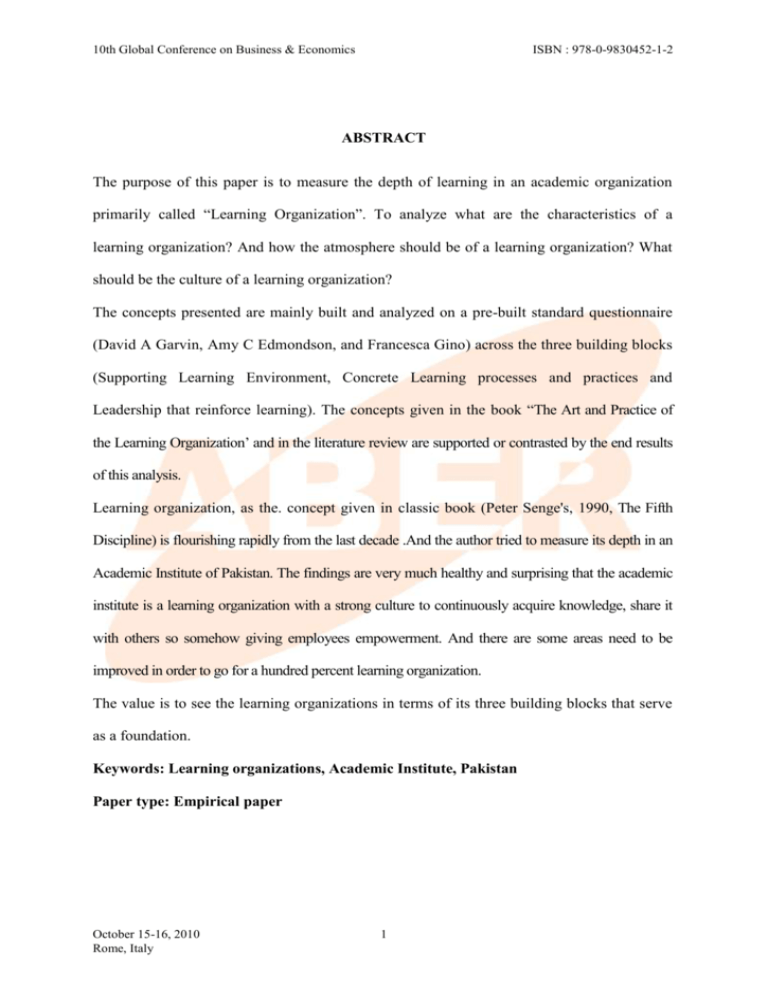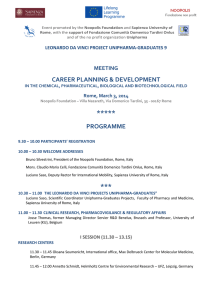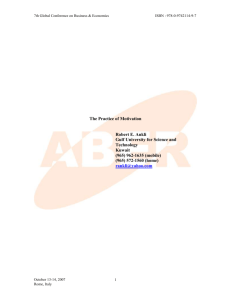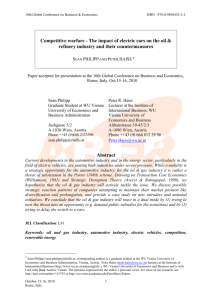An Academic Learning Organization A Case Study From Pakistan
advertisement

10th Global Conference on Business & Economics ISBN : 978-0-9830452-1-2 ABSTRACT The purpose of this paper is to measure the depth of learning in an academic organization primarily called “Learning Organization”. To analyze what are the characteristics of a learning organization? And how the atmosphere should be of a learning organization? What should be the culture of a learning organization? The concepts presented are mainly built and analyzed on a pre-built standard questionnaire (David A Garvin, Amy C Edmondson, and Francesca Gino) across the three building blocks (Supporting Learning Environment, Concrete Learning processes and practices and Leadership that reinforce learning). The concepts given in the book “The Art and Practice of the Learning Organization’ and in the literature review are supported or contrasted by the end results of this analysis. Learning organization, as the. concept given in classic book (Peter Senge's, 1990, The Fifth Discipline) is flourishing rapidly from the last decade .And the author tried to measure its depth in an Academic Institute of Pakistan. The findings are very much healthy and surprising that the academic institute is a learning organization with a strong culture to continuously acquire knowledge, share it with others so somehow giving employees empowerment. And there are some areas need to be improved in order to go for a hundred percent learning organization. The value is to see the learning organizations in terms of its three building blocks that serve as a foundation. Keywords: Learning organizations, Academic Institute, Pakistan Paper type: Empirical paper October 15-16, 2010 Rome, Italy 1 10th Global Conference on Business & Economics ISBN : 978-0-9830452-1-2 AN ACADEMIC LEARNING ORGANIZATION A CASE STUDY FROM PAKISTAN Sadaf Ashraf, MS-Scholar (Batch-VIII) Contact No:0300-7504189,E-Mail:sadafzuhrakk@hotmail.com Dr. Ahmed F Siddiqi, Associate Professor Contact No: 0300-8416362, E-Mail: afs.ahmedsiddiqi@gmail.com School of Business and Economics, University of Management and Technology, Lahore (Pakistan) October 15-16, 2010 Rome, Italy 2 10th Global Conference on Business & Economics ISBN : 978-0-9830452-1-2 AN ACADEMIC LEARNING ORGANIZATION A CASE STUDY FROM PAKISTAN Sadaf Ashraf, MS-Scholar (Batch-VIII) Contact No:0300-7504189,E-Mail:sadafzuhrakk@hotmail.com Dr. Ahmed F Siddiqi, Associate Professor Contact No: 0300-8416362, E-Mail: afs.ahmedsiddiqi@gmail.com School of Business and Economics, University of Management and Technology, Lahore (Pakistan) Abstract The purpose of this paper is to measure the depth of learning in an academic organization primarily called “Learning Organization”. To analyze what are the characteristics of a learning organization? And how the atmosphere should be of a learning organization? What should be the culture of a learning organization? The concepts presented are mainly built and analyzed on a pre-built standard questionnaire (David A Garvin, Amy C Edmondson, and Francesca Gino) across the three building blocks (Supporting Learning Environment, Concrete Learning processes and practices and Leadership that reinforce learning). The concepts given in the book “The Art and Practice of the Learning Organization’ and in the literature review are supported or contrasted by the end results of this analysis. Learning organization, as the. concept given in classic book (Peter Senge's, 1990, The Fifth Discipline) is flourishing rapidly from the last decade .And the author tried to measure its depth in an Academic Institute of Pakistan. The findings are very much healthy and surprising that the academic institute is a learning organization with a strong culture to continuously acquire knowledge, share it with others so somehow giving employees empowerment. And there are some areas need to be improved in order to go for a hundred percent learning organization. October 15-16, 2010 Rome, Italy 3 10th Global Conference on Business & Economics ISBN : 978-0-9830452-1-2 The value is to see the learning organizations in terms of its three building blocks that serve as a foundation. Keywords: Learning organizations, Academic Institute, Pakistan Paper type: Empirical paper INTRODUCTION & LITERATURE REVIEW In the nearly two decades since the publication of The Fifth Discipline: (Peter Senge’s, 1990) classic book, “The Art and Practice of the Learning Organization”, a revolution issue (Ching-wen Cheng, 2009) of "learning organization" become a significant trend for the academic area of organization development. The management of all areas among the business leaders is concerned to adopt such strategy to improve their organization. According to (Drucker, 1998), the concept of "learning organization" also includes education organizations; because education organizations have an increasing need to be more effectively in an ever-changing environment. To get along with this fast pace, competitive era around the globe, learning is the only tool for one’s survival ability and so as for the education world. There is no doubt that the educational institutes should focus on learning organization theme and transform themselves into learning organization to provide a continuum for the improvement process to meet the future challenges and needs. The idea of a learning organization in the Pakistan context is quite new and emerging. It is taken from the west still establishing its roots and the author is very much interested to know that whether the Academia has any concept and culture as a learning organization. The scope of the study is focusing on a academic institute in Pakistan. As it is said that there is still no well worn path to becoming a learning organization (Steven A. Cavaleri, 2008) to serve as a template for others. This often reflects that a wide variety of October 15-16, 2010 Rome, Italy 4 10th Global Conference on Business & Economics ISBN : 978-0-9830452-1-2 approaches are in use - based on differing understandings of what it means to be a learning organization. Learning organization defined as a one structure (Emery, 1993) in such a way that its members can learn and continue to learn within it. The organizational structure itself is an environment for continuing education. Organization learning is a very popular term but still it is felt that the topic have little consensus in terms of definition, perspective, conceptualization and methodology. While examining the dichotomy (Eric W.K.Tsang, 1997) between the two main streams of theorizing in the field and tried to integrate the two streams of research. The first stream, prescriptive writings is concerned with the question “How should an organization learn”? Targeting practitioners based on the consulting experience and seldom follow rigorous research methodologies. Descriptive research on organizational learning fall into the second stream which tackles the question “How does an organization learn?”The second stream basically deals with academic studies striving for scientific rigor. If we take the normative perspective of the learning organization (Swee C. Goh, 1998), it suggests that a set of internal conditions is required for an organization to become a learning organization. In this paper the author tried to describe the set of managerial practices or strategic building blocks of a learning organization. He also discussed the supportive organization design needed and the required competencies of employees as key foundation building blocks of a learning organization. The theoretical possibilities for assuming (James G. March &Johan P. Olsen, 1975) that individuals in organizations modify their understanding in a way that is intendedly adaptive even though faced with ambiguity about what happened, why it happened, and whether it is good. And to develop a theory of learning under such conditions, we probably require ideas about information exposure, memory, and retrieval; learning incentives; belief structures; and the micro development of belief in organizations. The concept of the ‘Learning organization’ October 15-16, 2010 Rome, Italy 5 10th Global Conference on Business & Economics ISBN : 978-0-9830452-1-2 with its roots in self development and action learning has recently caught the imagination of many organizations and researchers. Emerging definitions (Alan M. Jones & Chris Hendry, 1994) are creating ambiguity. There is, therefore, a need to add substance to them, and widen our understanding of what the concept means, by concentrating on what is meant by 'learning', and focusing on exactly how adults learn. In particular, learning and skills need to be linked to the questioning of purpose and value in an organization. If we look the organization learning in a joint venture (JVs) perspective (Andrew C. Inkpen & Mary M. Crossan, 1992) to develop the conceptual framework for the study of organization learning. It presents a multilevel view of the phenomenon and suggesting that learning in organization occurs at the individual, group and organization level. The framework integrates behavioral and cognitive perspectives of organization learning and delineates both learning processes and outcomes. The fundamental position is that a rigid set of managerial beliefs associated with an unwillingness to cast off or unlearn past practices can severely limit the effectiveness of organization learning. A framework is developed (Robin Snell, 1998) to access the organization learning and the depth, breadth and spread of members’ involvement. The study compared the perspectives of top management, reflected in popular and professional publications, with grass-roots accounts from Hong Kong subsidiaries. While developing the benchmark of the learning capability (Swee Goh, Gregory Richards, 1997), it is proposed to develop the benchmark of learning capability through identifying and measuring the essential organizational characteristic and management practices which are required to promote organizational learning. It would help managers to design interventions to overcome specific barriers in building a learning organization. An attempt is being made (Huysman M, 2000) to bridge the conceptual gap between the literature on the learning organization and that of organization learning. By developing October 15-16, 2010 Rome, Italy 6 10th Global Conference on Business & Economics ISBN : 978-0-9830452-1-2 understandings how an organization learns provide ideas on how this could be improved and thus could contribute to a more theoretical foundation of the learning organization. The three critique points to the concept of learning organization (John Coopey, 1995), first it is argued that the concept is badly flawed because of its proponents’ political assumptions. This lead to neglect the political activity likely to be encountered in a learning organization, activity which will tend to frustrate the learning aims. Second, learning organization model allows for greater employee empowerment the amount will probably be relatively modest in real terms. On the other hand, the power of managers, especially those at the apex of the organization, is likely to be enhanced by their privileged access to any extra informational and symbolic resources that are created by individual and collective learning processes. The third, and potentially the most damning, criticism is that the concept of the 'learning organization' is expressed in ways that provide raw material for managerial ideology, potentially constraining the meanings and actions of other employees so that they support the interests of the dominant coalition. In this study I tried to measure the learning proficiencies of the organization in Pakistani Context in detail. The environment that support learning, have concrete learning processes and practices and blessed with the leadership that reinforce the learning is truly a learning organization. I also try to explore the learning organization specially in Pakistani Context and to compare them on those lines as proposed by the western scholars This study established the result on the basis of a thorough survey to investigate that how much the organization is a learning organization in Pakistani context across its three building blocks(Supporting Learning Environment, Concrete Learning processes and practices and Leadership that reinforce learning) and is there any relationship between the management policies that affects employees learning process. October 15-16, 2010 Rome, Italy 7 10th Global Conference on Business & Economics ISBN : 978-0-9830452-1-2 THE HYPOTHESIS To analyze this statement “learning organization in Pakistan” is quite a general statement. And to reduce the scope and, I took only one Academic Institute of Lahore from Private Sector, based in Gulberg(shifted to Khayabane Jinah Road) , given the name XYZ for further interpretation. Now the quantifiable statement is “Is XYZ University a learning Organization”. RESEARCH METHODOLOGY For the empirical testing of the hypothesis, a survey is conducted. The scope of the hypothesis demands the accuracy, coverage soliciting intelligent sample. A simple random sample of 26 people has been taken from the two departments; faculty of Management Studies and Faculty of Information Technology. All of them are full time employees of the university. This sample consists of both male and female. All of them are from the same ethnic(South Asian Region). Average experience of the employees is 13 to 14 years. Questionnaire defined on 7-point Likert Scale is used for two building block; Supporting Learning Environment and Concrete Learning processes and practices; (1=Highly Inaccurate, 2=Moderately Inaccurate,3=Slightly Inaccurate,4=Neither Accurate Nor Inaccurate,5=slightly Accurate,6=Moderately Accurate and 7=Highly Accurate).For the third block; Leadership that reinforce learning, Questionnaire is defined on 5-point Likert Scale(1=Never,2=Infrequently,3=Sometimes,4=Often and 5=Always).Annexure-A is attached for questionnaire. SPSS version 17 and 16 are used for the statistical analysis. System specification are Windows 7 original, Intel Pentium processor T4300 (2.1 GHz, 800 MHz FSB) and 250 GB Hard Disk and 2GB memory. Microsoft office 7 Word is used for documentation purposes, MS-Excel for Table and calculation presentation. October 15-16, 2010 Rome, Italy 8 10th Global Conference on Business & Economics ISBN : 978-0-9830452-1-2 ANALYSIS To identify the characteristics of the XYZ University, items are loaded using Factor Analysis Principle Component Technique) to find the required results. In the output, three tables named Communalities, Total Variance Explained and Component Matrix were obtained respectively (Annexure-B). Total Variance Explained table loaded 13 components by default explaining 91.305% of the dataset. A Scree Plot (Fig-1) below is also reflecting on the same result. We found a curve from 1to 13 on it and afterward it became straight line. Scree Plot Component Matrix was extracted further, keeping the higher value and deleting the lower ones across the thirteen components. The final extracted matrix obtained, had left with 7 components on board . After profiling they were given the names “Vital Characteristic of a learning organization”, Employee Empowerment, Communication, Process and Experiment, and Organizational Work Efficiency, Management Support and Organizational Pressure. October 15-16, 2010 Rome, Italy 9 10th Global Conference on Business & Economics ISBN : 978-0-9830452-1-2 First component “Vital characteristic of a learning organization” comprehend only 4 to 5% of the first building block, supporting learning environment in XYZ University. It clearly shows that the university’s employees psychologically do not feel comfortable while discussing their ideas or sharing new ones. The results suggest that the university environment is not supportive for learning through employees’ contribution into the system. Employees do not believe that their suggestion would be taken care of, by the management. They believe that minority is involved in decision making. Although ,this university has a strong and continuous learning process as the component has the value of 40 to 45% .That the employees believe, university tries prototype before the actual idea, has strong information collection and analysis system. Information is continually collected on different parameters (e.g.; customer, technological trends etc) and further utilized for the betterment of the organization and employees. Results show that the leadership of the university is very affirmative to reinforce learning in its environment. And 45 to 50% respondents of the total from” Vital characteristic of a learning organization” component believe so. Management used to take input from all channels, acknowledge its limitations, ask probing question while encouraging multiple views and like to identify previous performance problems and method of improvement. Second component “Employee Empowerment” basically explains only the supporting learning environment. In these component respondents, identifies the problematic areas which need management attention. It describe that employees should be given some liberty to admit their mistakes openly. Because it is believed that if you will not commit mistake, you are not able to learn new things. Employees are overly stressed and find no time to review their work and it forces them to resist against management. October 15-16, 2010 Rome, Italy 10 10th Global Conference on Business & Economics ISBN : 978-0-9830452-1-2 In third, fourth and five components, Communication, Process and Experiment and Organizational Work Efficiency respectively, results show few numbers of responses focusing on the three blocks. In communication employee perceive that management will listen to them but in actual they are loaded and receive unnecessary schedule pressure. There experience is that management does not listen to them and do not like to be criticized. Communication between the employees should be friendly and straightforward. Process and Experiment focused only on second block and Organizational Work efficiency, circle around the first two building blocks but only few respondents are of the same point of view. In fourth place employees believe that university frequently experiments new ideas and it has certain process and procedure. And fifth describes that some employees may think that employees of the organization support learning by sharing information, they defined their own ways of working and university management support them in solving issues. Six and Seventh, Management support and organization pressure, former with only one observation supports the leadership that the management support and listen employees. Later with limited observation lying only in supportive environment and concrete learning process and practices explains that people in the university are willing to share information, management is supportive and employees explore and experiment with new ways of getting work done. But university management never revisits its established policies. DISCUSSION AND CONCLUSION Learning, being an intrinsic attribute of individuals, is present in any organization due to its human system, so it is an inevitable element of organizational life. Furthermore, learning is nowadays a topic of recognized importance in successful organizations, and managers know October 15-16, 2010 Rome, Italy 11 10th Global Conference on Business & Economics ISBN : 978-0-9830452-1-2 through practice that it is a key feature in a global and speedily changing world. My analysis result clearly shown that the XYZ University have a culture of learning through its employees, have formal processes and equipped with a visionary leadership. Across the three building blocks defined by other authors (David A Garvin, Amy C Edmondson, and Francesca Gino) and used by myself in the research, it is clearly proven that; Supportive Learning Environment: University does not have a very friendly and supportive environment for the employees. Psychologically employees are not satisfied that their mistakes will be ignored and difference of opinions will be welcomed during discussion. There contribution in suggesting new ideas might not be appreciated and lastly they feel that their routine and work pressure hardly allows them to think analytically or do some research work. University has no as such culture for the research activities. Concrete Learning Process and Activities: But we can say that university has concrete learning process and activities. The environment is open for the knowledge sharing; it found on individual level, between the employees groups and with the outside market as well. It is believed that the university frequently experiments new ideas, collect information from the customers, competitors on social and technological basis. It compares the performance with the rivals and also takes input from the university participants. It reflects that organization has a tendency to take its performance measure to upgrade according to market and technological needs. University management takes views during the discussion and also takes notice of the difference in opinion. University employees are given proper guidance on the time of induction and make them comfortable to adjust in the new system. For the grooming of participants and employees, university conducts seminars, workshops. University valued the experienced professionals and invites them to train the employees and October 15-16, 2010 Rome, Italy 12 10th Global Conference on Business & Economics ISBN : 978-0-9830452-1-2 participants according to the demand of the market. These results are very much in support of the (Emery, 1993) description of learning organization. The result also suggested that the organization Leadership is very promising and believe in group discussion. Management likes to be in contact with the employees and periodically arranges meetings to take employees input on certain issues, encourages participation from all channels even if difference of opinion exists. Management listens to each individual attentively and respects their views. As literature (Eric W.K.Tsang, 1997) described the dichotomy, this is exactly the answer of the question “how does an organization learn”. When the organization has formal set of processes and procedures, management believes in group participation then we can say that the university is a learning organization with one weaker area but it is still in the process of learning. It learns through employees, competitors, socio-economic trends and technologically. Literature focusing on (Swee C. Goh, 1998)imposing a set of internal conditions are required, this is supported by our research that when the management is very much focused with the university goal and there is a system running on the back then employees will automatically know their areas of the work. Hence having a clear picture ahead, they will enjoy their work and their productivity will improve. A recent research in a private organization on the same topic (unpublished work) with the same questionnaire has proven the same results that organizations in Pakistani Context are learning organizations. But they lack of supportive learning environment. They are partially practicing this thing but are not fully realizing the importance of supportive environment. They are emphasizing more on the concrete processes and procedures along with enthusiastic leadership. October 15-16, 2010 Rome, Italy 13 10th Global Conference on Business & Economics ISBN : 978-0-9830452-1-2 Contrary to this result another research (Unpublished work) in the private sector university with a different tool, has end result that the university environment is very supportive but other two are the weaker areas. University is practicing the learning organization culture but still need improvement by formalizing the processes and having a passionate leadership. SUGGESTIONS XYZ University should more focus on the environment. Research culture should be promoted inside so that employees engage in analytical work and this will not only improve the quality education but also participants and employees knowledge level. Employees should psychologically feel satisfied and they should not be given unrealistic time lines. Practicing as a learning organization is a great achievement in Pakistan Context. But the process should be continuum and positively contributing its shares to the society. REFERENCES Andrew C. Inkpen & Mary M. Crossan (1992). Believing Is Seeing: Joint Ventures and Organization Learning; Thiunderbird, American Graduate School of International Management, Arizona, University of Western Ontario, Canada Andrew C. Inkpen (2000). Learning through Joint Ventures: A Framework of Knowledge Acquisition; Thunderbird, American Graduate School of International Management Ching-wen Cheng (2009), A Study of the Current Learning Organization Profile to, Elementary Schools at Pingtung County, Taiwan ,The Journal of American Academy of Business, Cambridge , Vol. 15 , Num. 1 October 15-16, 2010 Rome, Italy 14 10th Global Conference on Business & Economics ISBN : 978-0-9830452-1-2 Dervitsiotis K. N (1998). The Challenge of Managing Organizational Change: Exploring the relationship of re-engineering, developing learning organizations and total quality management. Huysman M. (2000). An organizational learning approach to the learning organization James G. March Johan P. Olsen (1975). The Uncertainty of the Past: Organization Learning Under Ambiguity, Stanford University and University of Bergen John. C (1995). The Learning Organization, Power, Politics and Ideology Introduction; Department of Economics and Management, University of Dundee, Dundee DD1 4HN, UK Jones, A & Hendry. C (1994). The Learning Organization: Adult learning and organizational transformation. British Journal of Management, 5(2), 153-162 Mary. C & Tracy G (1996). Organizational Learning Research Profile. Peter Drucker (1994). On the Profession of Management. Boston, MA: Harvard. Dumaine, B. Mr. Learning Organization. Fortune, 130, 147. Robin Snell (1998). The Learning Organization: Learning and Empowerment for Whom? City University of Hong Kong; Management Learning, Vol. 29, No. 3, 337-364 Scott D. N. Cook (1993). Culture and Organizational Learning; San Jose State University ,Dvora Yanow California State University, Hayward, Journal of Management Inquiry, Vol. 2, No. 4, 373-390 Steven A. Cavaleri (2008) Are learning organizations pragmatic? The Learning Organization, Vol. 15, pp. 474-485q, Emerald Group Publishing Limited Swee . G & Gregory. R (1997). Benchmarking the learning capability of organizations; Consulting, Audit, University of Ottawa, Canada, Ottawa, Canada Swee C. Goh (1998). Toward a learning organization: the strategic building blocks. October 15-16, 2010 Rome, Italy 15 10th Global Conference on Business & Economics ISBN : 978-0-9830452-1-2 Tsang. E. W. K. (January, 1997). Organizational Learning and the Learning Organization: A Dichotomy between Descriptive and Prescriptive Research Human Relations, Volume 50, Number 1 Wesley M. Cohen, Daniel A. Levinthal (1990). Absorptive Capacity: A New Perspective on Learning and Innovation October 15-16, 2010 Rome, Italy 16








